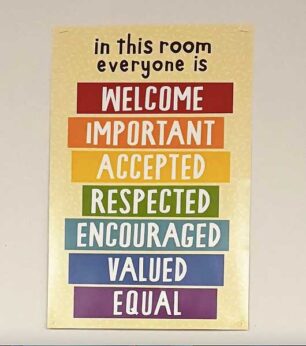
This kind of preemptive censorship creates a chilling effect on teachers, one of the most effective tools of authoritarian control. The state or other forces don’t have to police individuals if they are operating in a fearful environment where they police or censor themselves.
When questioned about the particular directive, West Ada School District spokesperson Niki Scheppers explained the district’s stance in an interview with the Idaho Statesman. “They felt it necessary or deemed it appropriate to create a policy that guided staff in creating content-neutral classrooms, not only for their own protection from parent complaints … [but] from removing political discourse from the classroom so that our teachers could focus on instruction.”
This removal of political discourse is, of course, selectively enforced by those in power. At the same time, the state mandates the presence of the American flag in every classroom and requires the daily recitation of the Pledge of Allegiance. Yet, lawmakers do not acknowledge these as political statements. Despite overtly nationalistic and religious lines such as “One Nation under God,” this is apparently content-neutral.
Even if we accept the premise that teachers should avoid explicit partisanship, does that mean they should refrain from affirming universal values like inclusion and respect? While educators have a responsibility to present multiple perspectives and critically engage with controversial issues, the expectation that they can be entirely free of bias or maintain complete neutrality is unrealistic. Every individual carries implicit viewpoints that shape their understanding of the world, and educators are no exception.
Furthermore, in social sciences like history, economics, and civics, meaningful instruction requires engaging with complex social and political realities. Expecting teachers to eliminate all political discourse from the classroom is not only impossible but also a detriment to the development of student’s critical thinking and civic engagement.
If schools are meant to prepare students for active citizenship, how can we justify stripping away discussions about the very society they are meant to participate in? Schools should be sites where we engage in democratic discussions to evaluate, critique, and pose solutions for our society. This kind of discourse is socially useful and extremely effective instruction. We cannot decouple questions of society from school—even with controversial or emotionally charged issues.
Appeasing white nationalists and xenophobic individuals

Yet, in the 21st century, this sign is not a controversial political statement by any reasonable measure. The real issue isn’t neutrality—it’s whose discomfort matters. One must consider who would be offended by the notion that everyone is welcome, showing the hands of different races. It seems the administrators are catering to the feelings of white nationalists and other xenophobic individuals in advance.
It’s an acceleration of the “paradox of tolerance” laid out by Karl Popper. Those of us who believe in egalitarianism and the inclusion of everyone do not have to cater to those who don’t. A tolerant and civil society should not accommodate those who are against tolerance and the inclusion of all people. Moreover, a rigorous and truthful education in history and civic engagement should be offensive to fascists.
Scheppers elaborated on the district’s reasoning in an email: “While the ‘everyone is welcome here’ poster conveys a message of openness, its imagery aligns with themes commonly associated with DEI initiatives,” referring to diversity, equity, and inclusion.
The teacher was also asked to remove a second sign that read, “In this room, everyone is welcome, important, accepted, respected, encouraged, valued,” with each word highlighted in a different color. The idea that this directive was intended to create a positive learning environment and improve instruction is an obvious excuse. The nationwide backlash against DEI (Diversity, Equity, and Inclusion) has increasingly revealed itself as overtly racist.
No complacency against fascism
After being told by administrators that her signs must come down, Inama initially complied but later reconsidered. The Statesman reported that she has been given until May to remove the display but is uncertain about her next steps. “It would not be easy or ideal to lose my job,” she told the Statesman. “I would miss my students immensely, and it would be a real financial hardship for me. But I just fundamentally feel so unsettled and disturbed by what they’re asking me to do. I just can’t be complacent.”
Defiant moments like these cannot stand on their own as mere symbolic gestures. They must be used as a call to sustained organizing. This is not a time when regular people can abdicate Democratic responsibilities to people in so-called leadership positions.
Teachers’ unions, parents, students, and community members must unite to resist these deliberate attacks on public education. This individual serves as a testament to the importance of standing strong in the face of censorship and not caving to the cowardice of administrators or the most reactionary and anti-egalitarian forces in our society.











